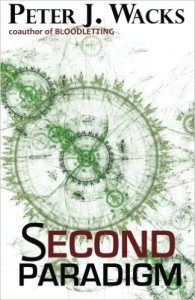 Second Paradigm‘s title refers to a new paradigm for thinking about time, time travel, and paradox, and its story is an exploration of that paradigm. The challenge in trying to tell you about a book as intricately plotted as this one is that just about anything I say risks being a spoiler. Still, I’ll take a crack at it.
Second Paradigm‘s title refers to a new paradigm for thinking about time, time travel, and paradox, and its story is an exploration of that paradigm. The challenge in trying to tell you about a book as intricately plotted as this one is that just about anything I say risks being a spoiler. Still, I’ll take a crack at it.
Second Paradigm revolves around a paradox and efforts by various time travelers to resolve it. The basic paradox has to do with the inventor of time travel, Dr. Christopher Nost, who is convicted of murdering a colleague, is shot dead in the parking lot after his trial, and then invents time travel — as long as the colleague he murdered is still alive.
Nost’s efforts to solve / prevent his own murder are only one of the story threads that track through Second Paradigm. The others involve a scientist from the far future who wants to save his wife from a certain death he believes the Time Corp has cynically sent her to, various Time Corp agents with private and public agendas, and even a god.
One of the unique aspects of this story is that is written in thirteen “Causes” arranged in a ring-structure. Each Cause collects several scenes, tracking through most of the story’s plot threads. Starting with any of the Causes, the story is readable forward, through the end, and back to the reader’s starting point. The intricacy of plotting necessary to make that work makes this a book that requires affirmative mental effort to follow, but that effort is rewarded. Second Paradigm is a first-rate, really provocative read.

 Follow
Follow





































